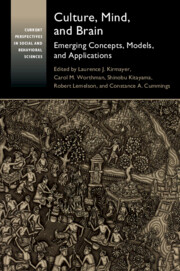Book contents
- Culture, Mind, and Brain
- Current Perspectives in Social and Behavioral Sciences
- Culture, Mind, and Brain
- Copyright page
- Dedication
- Epigraph
- Contents
- Figures
- Tables
- Contributors
- Preface
- Abbreviations
- 1 Introduction
- Part I Dynamics of Culture, Mind, and Brain
- Section 1 The Co-emergence of Culture, Mind, and Brain
- 2 Culture, Mind, and Brain in Human Evolution
- 3 Mutual Constitution of Culture and the Mind
- 4 Being There
- Section 2 The Situated Brain
- Section 3 How Social Coordination and Cooperation are Achieved
- Part II Applications
- Index
- References
3 - Mutual Constitution of Culture and the Mind
Insights from Cultural Neuroscience
from Section 1 - The Co-emergence of Culture, Mind, and Brain
Published online by Cambridge University Press: 18 September 2020
- Culture, Mind, and Brain
- Current Perspectives in Social and Behavioral Sciences
- Culture, Mind, and Brain
- Copyright page
- Dedication
- Epigraph
- Contents
- Figures
- Tables
- Contributors
- Preface
- Abbreviations
- 1 Introduction
- Part I Dynamics of Culture, Mind, and Brain
- Section 1 The Co-emergence of Culture, Mind, and Brain
- 2 Culture, Mind, and Brain in Human Evolution
- 3 Mutual Constitution of Culture and the Mind
- 4 Being There
- Section 2 The Situated Brain
- Section 3 How Social Coordination and Cooperation are Achieved
- Part II Applications
- Index
- References
Summary
Culture is composed of meanings (e.g., values, beliefs, and norms) and practices (e.g., conventions, scripts, and routines) that are shared, albeit unevenly, in a given community and group. Culture is integral to biological adaptation, not an overlay to the human mind but part and parcel of how the human mind functions. Since the mind is shaped through culture, it also contributes to the reproduction of culture. This chapter highlights a broad contrast thought to separate the West from the “rest,” with Westerners being more independent or less interdependent than non-Westerners, although non-Western regions themselves are highly variable, reflecting diverse adaptive strategies for achieving interdependence under varying socio-ecological conditions. We review existing behavioral and neuroscience evidence to support a broad distinction between the West and the non-West based on three core features of interdependence: predictors of happiness, holistic attention, and holistic social cognition. We also summarize recent evidence suggesting that culture influences cortical volume in specific brain regions. We conclude by pointing out that while cultural shaping of mentality is highly idiosyncratic at the individual level, it can nonetheless be systematic at the collective level, enabling faithful reproduction of the cultural system by which individuals have been trained and shaped.
Keywords
- Type
- Chapter
- Information
- Culture, Mind, and BrainEmerging Concepts, Models, and Applications, pp. 88 - 119Publisher: Cambridge University PressPrint publication year: 2020



